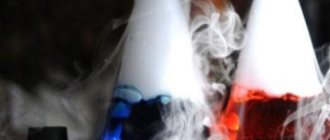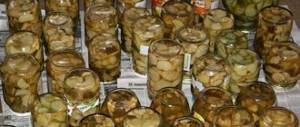Encyclopedia "Mushroom-Info" Mushroom Picker's Guide Are false chanterelles poisonous and how to distinguish them from edible species?
Fans of “mushroom hunting” value chanterelles not only for their excellent taste, but also for the fact that their pulp has no signs of worms or damage by insects. All this is thanks to the substance chitinmannose, which has the ability to destroy helminths and their eggs.
Many people like to collect chanterelles, because they grow in large colonies. If you find several pieces in front of you, look around, look under fallen leaves or moss. From one clearing you can collect 2-3 buckets of these delicious fruiting bodies. But novice mushroom pickers are concerned about the question: are chanterelles poisonous?
What mushrooms are poisonous?
The main danger in poisonous mushrooms for human health and life is the high content of toxins. These mushrooms are usually divided into three categories, depending on the degree of impact on the body:
- Local action – causing food poisoning, manifests itself two hours after consumption. Even some edible mushrooms can cause this reaction if not prepared correctly.
- Effect on the nervous system - a large group of mushrooms, which includes fly agarics (many species, for example, pineal, panther, toadstool), fibers (some species), talkers, rows, russula emetic, and sivyak. Also, hallucinogenic - the genus Psilocybe and Straphoriaceae. Their use threatens nausea, loss of consciousness, hallucinations, and increased sweating.
- Leading to death - the manifestation of the action of the poison occurs from 8 to 48 hours and leads to renal failure and cell necrosis.
This division of mushroom poisons is quite arbitrary, since the same poison will have different effects on different organisms.
The most common dangerous mushrooms are: pale toadstool, panther and stinking fly agaric, fringed galerina.
Conditionally edible mushrooms that are common in the central zone of our country include milk mushrooms, volnushki, valui, rows; pushers, violins, pigs, false chanterelles.
Conditionally edibles selectively affect the body, depending on the circumstances. Consumption of such mushrooms usually leads to moderate and severe poisoning. But, many mushroom pickers, despite such characteristics, still collect and process them. Long-term soaking of conditionally edible mushrooms is necessary, with periodic changes of water. The pickles must sit for at least one and a half months.
The nature of mushroom poisons has been studied quite well today; they are divided into two groups:
- Fallotoxins (phallins, phalloidins, phallacidins, etc.). Most of the mushrooms containing these poisons do not boil when boiled and have great heat resistance.
- Ammanitins are dangerous due to the fact that their effect does not appear immediately, for example, after consuming orange-red spider webs - from 3 to 14 days.
It must be remembered that treatment started late, on the second to fifth day, may be unsuccessful.
It is necessary to know the symptoms of mushroom poisoning - abdominal pain, nausea, vomiting, diarrhea. Also, you should pay attention to the agitation and anxiety that manifest themselves at the onset of the disease in case of poisoning with toadstool.
At risk are the elderly and children who are seriously susceptible to mushroom poisoning.
Beneficial features
On the picture. False chanterelles
Eating mushrooms not only satisfies a person’s need for nutrients, many consider them a natural medicine:
- Regular consumption of mushrooms prevents the appearance of cancer;
- chanterelles are indicated for people with vision problems;
- active components kill the hepatitis virus, restore liver cells;
- studies have proven that chanterelles slow down the proliferation of tuberculosis bacillus, an aspect that has a positive effect on the healing process;
- the product copes with the removal of radionuclides from the body, helps slow down the aging process;
- mushrooms are taken for the prevention and treatment of helminthic infestations.
The positive effect is achieved due to the high content of zinc, copper, vitamins A, PP, C, B, and D in chanterelles. Over time, more and more pharmaceutical companies are including extracts from chanterelles in their medicines. The drugs are intended to treat varicose veins, liver diseases, and even to get rid of depression.
First aid for poisoning with poisonous mushrooms
Before the doctor arrives, first aid must be provided:
- Rinse the patient's stomach - give 5-7 glasses of water, milk or a weak solution of potassium permanganate to drink.
- Induce vomiting - irritate the root of the tongue and the back of the throat with a teaspoon or finger (repeat 3 to 5 times).
- Put the patient to bed.
- Place heating pads on your legs and arms.
- Give warm drinks without interruption, and in case of severe weakness, strong tea.
If there are any mushrooms left after poisoning, take them to the laboratory for testing.
Differences between poisonous mushrooms and edible ones
The first thing you need to do is smell the mushroom; edible mushrooms have a pleasant mushroom smell, while poisonous ones have a nasty and unpleasant smell.
Many edible mushrooms have counterparts among poisonous ones and they are quite difficult to distinguish. In this case, you need to look at the description of the mushroom in the encyclopedia. But the most important advice that can be given to a mushroom picker is – if you’re not sure, don’t take it.
Preventive actions
Mushroom poisoning can be dangerous, especially for children and the elderly. Therefore, it is better not to allow it.
Rules for collecting and preparing chanterelles:
- You can collect mushrooms only in ecologically clean areas, away from landfills, roads and factories.
- Carefully inspect each mushroom. It must be clean and undamaged. Particular attention should be paid to the signs that allow you to distinguish a real fox from a talker.
- Mushrooms after collection can be stored for no more than 12 hours. Immediately upon arriving home, they need to be sorted, washed and subjected to heat treatment or salting.
- Salted and pickled mushrooms are stored in a cool, dark place. And only those that do not cause the slightest suspicion are used.
Pale toadstool mushroom description photo
The most poisonous mushroom is considered to be the toadstool (belongs to the fly agaric genus). Even a small portion of such mushrooms can be fatal. Often found in nature, it has doubles. It grows in temperate regions, on fertile, moist soils. You can meet the pale grebe, starting from the end of summer, not only in the forest, but also in your garden.
These mushrooms grow in groups, rarely alone. Consists of a stem and a cap, the young mushroom is covered with a film. The cap is from 5 to 15 cm, with an olive, greenish or grayish color. The cap is flat or hemispherical with smooth edges and a fibrous surface. It has white pulp, without a pronounced sweetish taste or smell. The thick plates on the cap are not attached to the stem.
The stem of the mushroom has a cylindrical shape, thickened at the base, from 8 to 15 centimeters long, with a diameter from 1 to 4 centimeters. The coloring is the same as the cap, often with a noticeable moire pattern. On the upper part there is a ring, on the lower part there is a tuberous thickening enclosed in a greenish or white film.
Inexperienced mushroom hunters may confuse the pale toadstool with some edible mushrooms, for example, champignons and greenish russula.
Mycelium and spores are also poisonous. It is not recommended to collect berries and other mushrooms near the toadstool.
Where do orange talkers grow?
Common and false chanterelles grow in different places in the forest. However, they prefer coniferous and mixed plantings, high humidity and warm conditions. The common chanterelle forms mycorrhiza with various trees - pine, spruce, beech, oak. The main ripening period is in early June, then from August to mid-autumn.
The orange talker is found on the forest floor. She does not require symbiosis with trees. False chanterelle grows in deciduous and coniferous areas. The food source is rotting wood and leaves. Often the yellow forest beauty is found in moss or near anthills. Mushrooms are collected in temperate climates of Europe and Asia.
The orange talker mushroom actively develops after rains. Increasing humidity and temperature creates favorable conditions for growth. Fruiting bodies are found near streams, lakes, and rivers. During drought and after frost, the likelihood of encountering a false chanterelle is lower.
False chanterelle grows singly or in large groups. The mycelium bears fruit annually. Ripening begins in August and lasts until November. Most mushrooms are found in mid-August and September.
Galerina bordered how to distinguish
According to studies, the fringed galerina contains amanitine poisons, which are characteristic of the stinking fly agaric and the pale toadstool. It is a deadly mushroom; when consumed, it destroys the liver, causing chills, vomiting and diarrhea. Help not provided in time leads to death.
An uninformed mushroom picker can easily confuse it with honey mushroom. But, it can be distinguished by several characteristic features.
- The bordered galerina is much smaller than the honey fungus, the diameter of the cap is no more than 4 centimeters.
- The edible mushroom has scales, while the galerina does not.
- Galerina grows on rotted wood of coniferous trees.
- Summer honey mushrooms form clumps, but Galerina never forms them, although it grows crowded.
Satanic mushroom description photo
Externally, this mushroom is quite attractive and very similar in appearance to oak or white. On the territory of our country it is found in mixed forests and oak forests. Starting in June, the active growth phase begins. The size of the cap can reach 30 centimeters, gray or olive in color. The stem has a yellowish tint, turning yellow-red, with a mesh pattern. The height of the stem is up to 15 cm, with a thickness of up to 10 cm. Depending on the stage of development, the plates at the bottom of the cap change color from greenish to yellow, as well as orange and red. When cut, the flesh of the mushroom is pink, then turns blue. When cut, a young mushroom exudes the smell of rotten onions, while a mature one smells like carrion.
It should be said that in Europe, the satanic mushroom is considered conditionally edible and, after processing, is eaten. Long soaking in water is necessary, after which the mushroom pulp becomes tasteless.
According to WHO findings, it is enough to eat just 10 grams of the raw pulp of the satanic mushroom to cause cardiac arrest or paralysis of the nervous system.
Fly agaric poisonous mushroom
Fly agarics are found in Russia, Asia, Europe and Australia. The mushroom has different colors - white, gray or deep red. The hat measures up to 20 centimeters. As it ripens, white flakes form on the cap, which are the main difference. Despite their external attractiveness, it is better to avoid fly agaric mushrooms. The poison of the mushroom acts instantly; it is practically impossible to save people with chronic diseases from death.
The stinking fly agaric is the most dangerous species; it does not have such a beautiful appearance and looks like a toadstool. If you cut it, you can smell a foul, unpleasant odor.
Fly agaric contains toxins that are not destroyed during processing. After a few hours, characteristic symptoms appear. During this time, irreversible processes begin and time for treatment is lost.
It happens that the condition improves after three days, but the process of liver destruction continues, death can occur after 10 days.
Treatment
Restoring the body and taking special medications is carried out only in a hospital under the supervision of experienced doctors. The treatment regimen for false chanterelle poisoning includes several stages:
- cleansing the body of toxins (Corvalol, glucose solution). The drugs are administered intravenously;
- if necessary, support the liver, kidneys, and heart with special medications (Gepabene);
- if the cause of intoxication lies in other factors (infection, chemical poisoning), treatment will consist of taking special medications aimed at eliminating the harmful effects of certain substances and microorganisms.
Important! Do not take any serious medications on your own: using unnecessary medications aggravates the situation, and there is a high risk of complications and allergic reactions.
Chanterelle toadstool mushrooms or not
Compared to the real chanterelle, the false chanterelle has a brighter color, often orange with a brownish tint, lighter at the edges than in the center. The hat feels velvet to the touch.
The legs of false chanterelles are reddish-orange and thin; in adult specimens, they are hollow inside and clearly separated from the cap. Edible chanterelles do not have hollow legs and no demarcation from the cap. false chanterelles have white spores, real chanterelles have yellow spores.
It is believed that false chanterelles cause serious harm, but they can rather be classified as conditionally edible. The most that can happen is an upset stomach.
Video Five of the most dangerous mushrooms in Russia
Video Pale grebe
PS When going to the forest, you need to clearly understand which mushrooms you can pick and which you cannot. Even experienced mushroom pickers sometimes make mistakes. You should never pick mushrooms that you doubt are edible.
We recommend reading the article on our website How to grow tomatoes on the balcony.
How to collect chanterelles (false and real), what are the differences, how to cut without damage
Hunting for mushrooms – any kind! – implies knowledge of tricks, mushroom places and search secrets. Chanterelles - false and real - tend to hide their bodies in pine needles or, less commonly, in fallen leaves. However, if you notice at least one red tail, you can be sure that you have come across an entire plantation. Most often they settle in moss. It is enough to lift its layer - and here you have a whole basket of harvest. When the weather has not been pleasant with rain for a long time, you need to look for chanterelles in damp places, in grassy lowlands. But if there was a lot of precipitation, they move to higher ground or well-warmed clearings. In any case, trees growing nearby can serve as reference points, since chanterelles huddle close to oaks, birches, beeches, pines and spruces.
The signal for the beginning of the fox season can be the abundant flowering of wild raspberries. And if before it began there were thunderstorms with downpours, then there is no doubt about the success of the “silent hunt”. If there are no such obvious signs, exploration should begin from the end of June.
Unlike most forest mushrooms, chanterelles require a special approach when collecting. Under no circumstances should they be cut, much less plucked: this damages and, over time, kills the mycelium, resulting in the disappearance of the existing plantation. If you unscrewed the mushroom, then next year you can confidently come to the same place for new prey.










